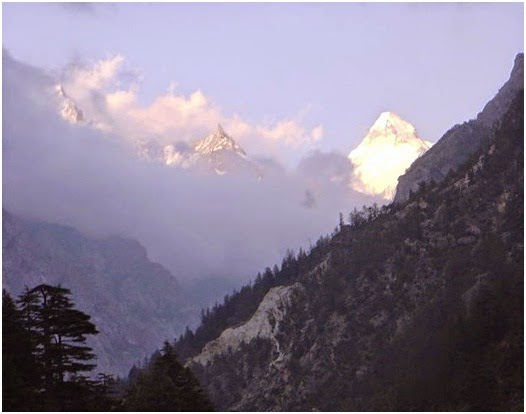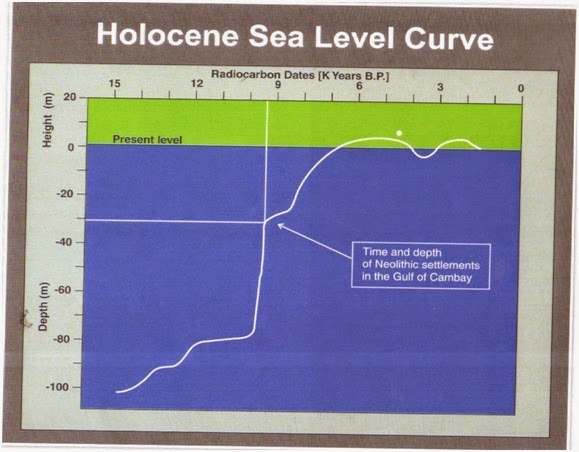Story of origin of Ganga narrated in valmiki ramayan -
'Descending
from the sky-high Shivalinga peaks of Himalayas, Ganga got entangled in the
mighty serpentine glaciers spread all around like matted coils of Lord Shiva's
hair and thus continued to meander in the Gangotri glaciers for many years.
With the superhuman efforts of Suryavanshi king, Bhagirath, its waters were
brought to the terrestrial planes and it flowed through the path dug by Sagar
putras/sainiks and its waters flowed right upto Rasatala ie.samudra, and thus Bhagirath could offer tarpan to his
sixty thousand ancestors'.
It
is described also as Tripathaga as it carves its way from heaven (i.e. Shivalinga
peaks), through matted coils of Shiva's hair (i.e. mighty gangotri glaciers) and
finally flows in subterranean region, right upto Ganga sagar.
This
in short is the story of origin of Ganga narrated by Rishi Vishwamitra to Shri
Ram (Ramayan, Baal kand, sargas 38 to 45)!. For those who are looking for
divine interpretation - Ganga descended from heavens, got entangled in
Jata-joot of Lord Shiva and then came to earth. For those who are looking for
rational and scientific meaning, Ganga (Bhagirthi) descended from Shivalinga
peaks, meandered through Gangotri Glaciers and flowed through the plains of
northern India, right upto Rasatal (Gangasagar), the route for which had been
dug out under the orders of raja Sagar. Let us look at just one picture of the
region to appreciate that both divinity and reality aspects are correct and
represent wonderful poetic skills of Valmiki Ji -
Astronomical
dates of sky views depicted by Aadi Kavi Valmiki Ji at the time of important
events in Lord Ram's life match sequentially around 5100 BC. Lord Ram was the
64th ruler of Suryavansh, whereas Sagar was its 40th ruler and Bhagirath 44th
ruler. This will take us to around 6000 BC (8000 BP).
Raja
Sagar was worried that north western Bharatvarsha was getting flooded whereas
eastern areas of Indian sub-continent were suffering from acute water
shortages. Consequently he made a plan to divert waters from Himalayas to the
eastern areas right upto Bengal areas and then, as was the custom in those
days, he commenced a Yajna (sacrificial performance), which was to be concluded
only when sacrificial horse was brought back from such far off destination.
The
horse was taken to Kapil Muni's Ashram, probably modern day Gangasagar, Sixty
thousand sons (Sainiks of Sagar) were sent to dig out the route right upto
Rasatal (1/39/15,19,21).When they came back without the horse after carrying
out digging, they were sent back by Raja Sagar to redig on the same route and
then due to shortage of water combined with inhospitality of Kapil Muni, they
all died (1/40/11). For next 32 years, Sagar could not think of any concrete
plan to divert Himalayan waters towards the East through the dug-out path and
died after about 32 years. His grandson Anshuman made efforts for 32 years but
could not get the Ganga waters reached for the tarpan of his ancestors.
Similaly his successor Raja Dilip made efforts for another 30 years but could
not succeed.
Raja
Bhagirath was coronated as the 44th Suryavanshi samraat. However, in order to
save his praja in the north west from
deluge and in the east from draught and in order to reach Ganga waters to
rasatal for the tarpan of his ancestors, Raja Bhagirath went to Himalayas after
leaving the affairs of the kingdom on his mantris,
For several years he carried out research and exploration, observing the
Shivalinga peak from the hill top which was shaped like the tip of the thumb,
and was later named as Bhagirath peak (1/43/1).
Finally
with the blessings of Lord Brahma and lord Shiva, he succeeded in identifying
the mighty Gangotri glaciers, looking like jata-joot of Lord Shiva, in which
Ganga waters were entangled (1/43/4,7). After some more research, he identified
and also partly created the route through which waters could be carried to the
wide spread routes got dug by his ancestor Raja Sagar and thus succeeded in
completing the kalyankari project
which his ancestors had started 1/44/1,28,12). In this manner sacred Ganga
descended from the sky on Shiva's forehead and then flowed onto the earth;
roaring, tumbling and gliding, it reached the sea (gangasagar). (refer -
1/43/15,23,24).
Sea
level fluctuations fully support the above details and reveal very clearly that
water level in the sea rose drastically during 8000 BP to 7000 BP. Look at the
sea level curve prepared by Dr. Rajiv Nigam of National Institute of
Oceanography (NIO). Surprisingly reference to this phenomena has also been made
in Yudhh Kaand of Valmiki Ramayan (6/19/31 & 6/22/50), where Vibhishan is
mentioning to Lord Ram that the sea should reveal the shallow water route for
construction of a bridge because its waters had been augmented by ancestors of Lord
Ram.
Remote
sensing imagery explained by Sharma and Bhadra of ISRO Jodhpur centre seems to
be corroborating these details and time line. Further somewhere around 5000 BP,
Yamuna, which was a tributary of Sarasvati got diverted to Ganga.
Archaeological reports support these conclusions with plethora of evidence. Thus,
in early Rigvedic period Sarasvati was the mightiest river, whereas in later
Vedic age Ganga, Sindhu and Sarasvati were worshipped as the mighty rivers.
Slowly Sarasvati disappeared as it became non perennial and ephemeral. Ganga
emerged as the symbol of life and emancipator of mankind. She is worshipped as the
divinity in flow.
For
some related details refer to -
1) Saroj Bala and Kulbhushan Mishra. 2012. Historicity of Vedic and Ramayan Eras: Scientific Evidences from the Depths of Oceans to the Heights of Skies. Institute of Scientific Research on Vedas. Abridged editions also available in English and Hindi.
Srimad Valmiki Ramayana (Hindi)
Srimad Valmiki Ramayana (English)



A great story told.
ReplyDeleteMetaphysics university
Metaphysics school
Metaphysics college
Metaphysical university
It is so interesting to read the Origin Story by Valmiki and then something that resonates with scientific aspect (with proper facts). Thanks a lot for sharing this.
ReplyDeleteTrue
ReplyDelete